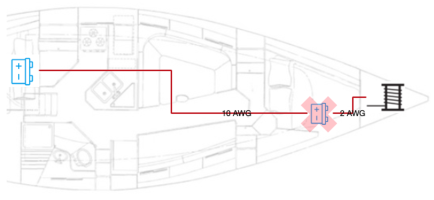Tooluser
Flǎneur
S/V Nobody has a bow windlass. Historically (and stock for the E38) it was powered by a lead-acid battery located in the bow. This battery can be ganged to the house bank (and thus the alternator, theoretically) by a switch for charging over a long (~50’ round trip) pair of relatively thin (#8 or #10 AWG) wires.

Current situation, with a dead windlass battery.
The battery in the bow is currently dead. How should I replace? The dollar cost ends up approximately the same. Anything I'm not considering?
A few salient facts:
Cost: $250-300 with a DC-DC charger.
Time: 5/5
Pro: Sail more.
Cons: Stay heavy in the bow. Replace the AGM every N years. Will a charger do a good job over that distance/voltage drop? Probably, with reasonable fiddling. (I'd buy an Orion.)
Cost: $350 with a DC-DC charger
Time: 5/5, easy
Pro: Lose a lot of weight (70lbs, and up high) in the bow. Battery lasts much much longer.
Con: Lithium hassle.
Time: 3/5 pulling fat heavy cables
Pro: Lose all the weight in the bow, no battery to wear out
Con: All that work. Gods know what else I’d find, too.

Current situation, with a dead windlass battery.
The battery in the bow is currently dead. How should I replace? The dollar cost ends up approximately the same. Anything I'm not considering?
A few salient facts:
- I have run this windlass over the AWG 10 cable, gingerly, even with the ‘dead’ battery. It worked fine! I was a bit surprised. Yes it has OCP. It’s possible it’s #8 or #6. But still not ideally sized for full-time running off the engine/house.
- The windlass should be considered a 100A load. Seawolf.
- The anchor has a significant amount of chain, but an AGM battery is 80 pounds so don’t be telling me this battle doesn’t matter.
- Replace battery in situ with AGM. Potentially add DC-DC charger to keep it topped up rather than just ganging them all together.
- Replace battery with Lithium, add DC-DC charger for the purpose.
- Remove battery, replace small cables with #2s.
Options Detail
Replace with fresh AGM
This wins on simplicity. Toss the old one, get a new one.Cost: $250-300 with a DC-DC charger.
Time: 5/5
Pro: Sail more.
Cons: Stay heavy in the bow. Replace the AGM every N years. Will a charger do a good job over that distance/voltage drop? Probably, with reasonable fiddling. (I'd buy an Orion.)
Replace with Lithium
Lithium batteries capable of the necessary cranking amps do exist. A 50Ah battery would be plenty. That said, this is a slightly experimental approach.Cost: $350 with a DC-DC charger
Time: 5/5, easy
Pro: Lose a lot of weight (70lbs, and up high) in the bow. Battery lasts much much longer.
Con: Lithium hassle.
Replace with #2AWG cable
Cost: $225 worth of cableTime: 3/5 pulling fat heavy cables
Pro: Lose all the weight in the bow, no battery to wear out
Con: All that work. Gods know what else I’d find, too.
Decision Matrix
| Option | Cost | Time | Pro | Con |
|---|---|---|---|---|
| New AGM | $350 | 5/5 | 0/5 | 4/5 |
| New Lithium | $350 | 5/5 | 2/5 | 2/5 |
| Pull the cables | $250 | 2/5 | 3/5 | 3/5 |


 Just teasing!
Just teasing!